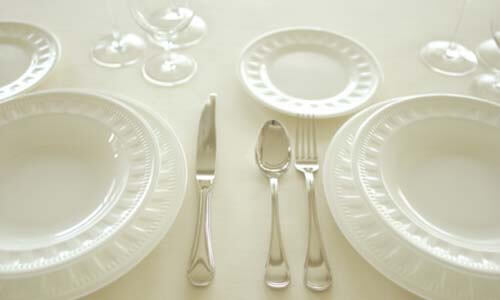Glassware
Table Setting Guide
Stemware has a bowl that rests on a stem, anchored by a foot. The purpose of this design is to serve cool beverages, such as water, iced tea, and wine. The stem provides a way to hold cool drinks without warming the contents of the bowl. (The exception is the brandy snifter, which is cradled in the hand to warm the brandy and enhance its flavor.)
The bowls of contemporary stemware come in three main shapes.
- Bucket-Shaped Bowl. The bucket-shaped bowl is similar to a bucket, with a horizontal base and almost vertical sides.
- Tulip-Shaped Bowl. The tulip-shaped bowl resembles a tulip, with a rounded base and sides that curve inward.
- Flared Bowl. The flared bowl is shaped like a trumpet or a funnel, a long, narrow form made with a pointed or slightly rounded bowl that either flares outward at the top or remains straight.
Beverages should be paired with the appropriate bowl size:
The purpose and size of the following six pieces of stemware is presented on the left in the order in which the vessel is used at the table, from preprandial drinks to those served after dinner. The three topics on the right are covered in companion glassware pages.
Aperitif Glass
Water Goblet
Iced-Tea Glass
Wine Glasses
(including White Wine Glasses, Champagne Glasses, Red Wine Glasses, and Dessert Wine Glasses)Cordial Glasses
Brandy Snifters
Placing Glassware
How to Set a Table - Placing Glassware. Where to Place the Water Goblet, Wine Glasses, Sherry Glasses, White Wine Glasses, Red Wine Glasses, Dessert Wine Glasses, Champagne Glasses, and Juice Glasses.
Purchasing Glassware
Stemware Buying Guide: Long Stemmed Stemware or Short, The Weight of Stemware, Clear Stemware or Colored Stemware, Stemware Shape and Density, How to Mix and Match Stemware, The Number of Stemware Pieces per Place Setting, How to Judge the Quality of Stemware, How to Judge Crystal.
Care of Glassware
How to Care for Glassware: including Caring for Crystal Glassware, Care of Machine-Made Glassware, Homemade Cleaning Solutions for Glassware, and Storing Glassware.
Aperitiff Glass
The aperitif (pronounced ah-pare-i-teef) is a drink fortified with approximately 15 to 20 percent alcohol. Its purpose is to "open" the gastric juices and stimulate the appetite before a meal.
Common aperitifs include:
Because aperitifs are high in alcohol, only 2 to 3 ounces are poured and the aperitif glass is small. But when champagne is served as a preprandial drink, because the alcohol content is lower than that of an aperitif, the champagne glass is used, a larger vessel filled almost to the rim.
The only time an aperitif glass is placed on the table is when sherry is served to accompany a course in which sherry is an ingredient, such as oxtail, lentil, or black bean soup.
Water Goblet
Because water is drunk throughout a meal, the goblet is the largest vessel in a set of stemware and holds approximately 6 ounces when filled three-quarters full.
The goblet is always used in formal dining, but at an informal meal it is an optional table appointment. A multi-course menu incorporates a variety of seasonings and to refresh the palate and cleanse the taste buds between wines, water is served.
Why is wine presented in a "glass," and water in a "goblet"? The answer lies in the nature of the material. Because metal imparts a metallic taste to wine, acidic beverages are served in glass vessels. Conversely, water does not extract a metallic taste from metal and is served in numerous materials, among them glass and metal.
Iced-Tea Glass
The iced-tea glass is a long, narrow vessel with a short stem, a shape made to accommodate ice cubes. Because water and wine are the only beverages served at a formal table, the iced-tea glass is reserved for informal dining, from elegant to casual. The shape is ideal for cold beverages of any kind, such as tomato juice or iced coffee.
Wine Glasses
Although the average wine glass holds 8 to 12 ounces when filled to the rim, the flavor of wine deteriorates when exposed to oxygen, and only 3 to 4 ounces are poured.
To enhance flavor, wine is served cool, and to preserve the temperature the wine glass is usually held at the bottom of the stem between the thumb and the first two fingers. The wine glass may also be held with the thumb on the foot and the index finger or the first two fingers underneath the base, but it is rather awkward and likely to spill.
To test the quality of French wine, the Paris Institut National des Appellations d'Origine (INAO) designed a wine glass with an egg-shaped bowl, relatively short stem, and wide base. The bowl allows room to swirl the wine and release the bouquet upward to the nose, a shape considered ideal by oenophiles. The INAO glass is made of undecorated clear glass to reveal the clarity and color of wine.
The shape of the rim affects the taste of the wine. The flavor of wine is encountered primarily on the tongue, and only secondarily by the nose.
The wine glass is made in assorted shapes to balance the flavor and bouquet and promote the best characteristics of specific wines. Some bowls are wide and round, others are deep and narrow, and the rims curve inward or outward to varying degrees.
White Wine Glasses
The white wine glass is made with a bowl slightly smaller in diameter and with sides a little straighter than a red wine glass, a shape that concentrates the flavor and releases the delicate bouquet.
Approximately 3 ounces of white wine are poured into the glass. However, the difference in size between the white wine glass and red wine glass is so negligible that either wine can be served in the same size glass, but to concentrate the delicate bouquet, approximately an ounce less of white wine is poured than red wine.
Champagne Glasses
The champagne glass is made in seven shapes. The tulip glassis widest in the middle of the bowl with a rim that curves inward, a form that directs the taste of champagne to the center of the tongue for best balance of fruit and acid, and concentrates the bouquet, a glass preferred by wine connoisseurs.
The flute and trumpet glasses feature long, narrow bowls.
When drinking from either glass, the head is tilted backward, a position that allows champagne to flow over the tongue.
Red Wine Glasses
To release its aroma, red wine is served in a glass with a slightly larger bowl and a little taller overall than the white wine glass. Because the red wine glass is known by various names, making the right choice can be daunting.
Dessert Wine Glasses
Dessert wine is a sweet-tasting wine with a high alcohol content. A few ounces are served in a glass made with a slightly smaller bowl than a white wine glass. However, the shape is specialized, and more often dessert wine is served in the white wine glass.
In the mid-nineteenth century, after the table was cleared for dessert, fruit, crackers, and walnuts were passed, and to compliment the flavors, a decanter of port was placed before the host who poured for the person seated to his right. The host then filled his own glass and passed the decanter to the left around the table, a clockwise custom attributed to a time when ships were steered by oars carried on the right side and moored in port on the left side. Another tale credits the custom to the sun's orbit. Traditionally, a decanter of port never rests on the table until it is returned to the host.
Cordial Glasses
Cordial is a sweet libation with a high alcohol content. Cordials are served to warm the heart with a sense of conviviality and occasion and to act as a digestive following a heavy meal.
Cordial glasses, also known as liqueur glasses, are the smallest glasses in a set of stemware. Although some cordials are larger than others, the larger size holds approximately 2 ounces of liqueur, and the smaller size, called a pony, serves about 1 ounce.
Brandy Snifter
The brandy snifter, also known as a brandy inhaler; is a short-stemmed glass with a tulip or balloon-shaped bowl.
Because brandy is about 40 percent alcohol, only 1 or 2 ounces are poured, and the size of the snifter is not that important. The salient point is to serve brandy in a glass with an inward-curved rim to concentrate the heady bouquet.
Brandy is aged in oak barrels, which add to the complex flavor. The taste is enhanced when it is served warm or at room temperature. To generate warmth, the short stem is held between the fingers and the bowl is cradled in the palm of one or both hands. Brandy may also be heated over a small alcohol burner.



